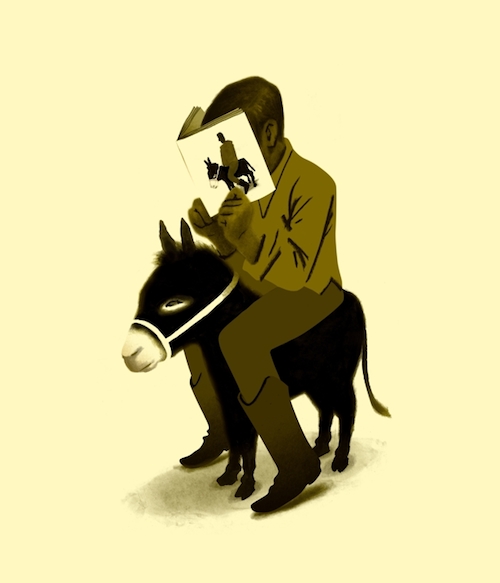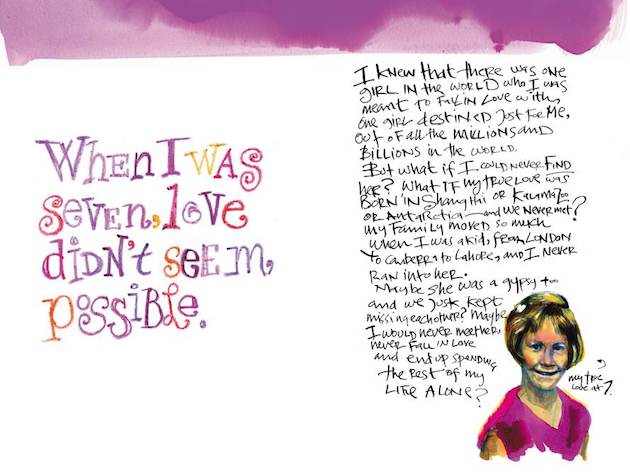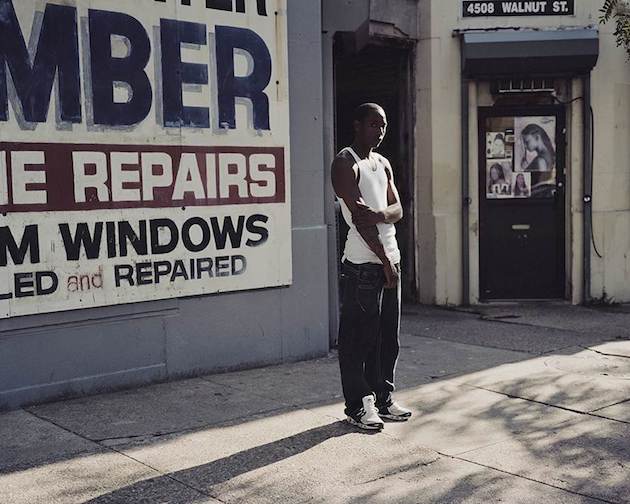Editors' Favorites From 2013
The staff choose their most-liked pieces published in 2013: a trip to Patsy Cline's divided hometown, the complete biography of North West, a cold case of hit-and-run, and no shortage of great quotes about dead bodies.

“A Closer Walk With Thee,” by John Lingan
Kate Ortega: I loved John Lingan’s profile of Patsy Cline’s hometown and the tear in the city’s social fabric caused by the singer’s rapid rise from the wrong side of the tracks. From the descriptive opening lines, which place the reader on the sidewalk outside Patsy’s small frame house, to the closing scenes at a memorial service arranged by fans, the piece uses rich description, thorough research, and lots of on-the-ground color to tell a memorable tale.
“Everything in This City Must,” by Alexander Chee
Liz Entman: Alexander Chee’s lovely, ranging meditation on his year teaching in Leipzig and his jarring return to the States reminded me intensely of a summer I spent in Prague 15 years ago—down to the beer, the bread, and the unceasing micro-bewilderments of navigating a world similar to but not quite exactly like my own. And, likewise, the discombobulation of coming home after that foreign place has gotten under your skin, to a place that will maybe never feel as much like home as it did before.
“I Wish That We Could Both Be There,” by William Dettloff
Bridget Fitzgerald: A small-town tragedy, a witness’s testimony, a history of cars vs. pedestrians. William Dettloff dives into an old case and makes the 1974 New Jersey accident feel like a true-crime story in your own hometown. The kids could exist today, and the roads do. His account marks the difference between experiencing trauma as a child and as an adult—and there isn’t a happy ending.
The Headlines Section
Mike Deri Smith: I need a way to filter Twitter or quit it completely. I compulsively switch to it when I’m feeling a little thirsty for news, but it’s a pressure washer to the face. It’s so pain-some to find the good stuff while having to wade through viscous stuff of nothing to get to it. Margaret Atwood said Twitter is “something like having fairies at the bottom of your garden,” but most of those fairies are dicks most of the time, wasting my heartbeats. That’s part of the charm I guess. That’s also why TMN’s daily Headlines remain such a welcome life-raft. Even working in a newsroom, staring at the news and news-wires (and Twitter) all day long, consuming and barfing up news non-stop, the Headlines remain, somehow, such a relief when they are delivered at around lunch in London. I steal stories, appear smart, and usually know what I know about what’s new, extraordinary and important because the Headlines told me.
“Les Ambassadeurs du Mali,” by Elizabeth Kiem
Karolle Rabarison: “Les Ambassadeurs du Mali” by Elizabeth Kiem is not your average music review. I love how, beyond being a music guide, it connects music, politics, history, and current events into a unique glimpse at a country that, let’s be honest, most Americans probably know nothing about. And what good is reading if we don’t learn anything from it, right? There’s no telling what the year ahead will bring for Mali. Though elections have been held, the prospects for restoring peace and democracy remain complicated. Timbuktu’s Festival au Désert will stay “in exile” in 2014 due to security concerns, but I would welcome a follow-up piece from Kiem when music—and peace—does return to the desert.
“End Zone,” by Miranda Popkey; “Exploring the Language of the Stars,” by Kevin Fanning; “Albums of the Year,” by Andrew Womack
Nozlee Samadzadeh: A beautiful essay is a wonderful thing, sure, but it’s no match for a series of beautiful essays—all of my TMN favorites this year were continuations of existing work. I know absolutely nothing about football, but Miranda Popkey’s “End Zone” series was required reading for me, from the butt fumble to her measured, responsible take on the sport’s inherent violence. Kevin Fanning is the Cassandra of our time and we should pay heed to his warnings before it’s too late: he wrote the only piece worth reading about North West before she was even born, and then he wrote the only complete biography of her worth reading before she could lift up her own head. Finally, Andrew Womack has written a “Top Albums” article every year for the past five years, and it’s no coincidence that they are also my five favorite pieces of music writing from the past five years, too. Experience built over time trumps a one-off any day, you know?

“Brief Interviews With Very Small Publishers,” by Nikkitha Bakshani
Angela Chen: I work for a very large publisher, so of course I loved Nikkitha’s Bakshani “Brief Interviews With Very Small Publishers.” The world of Mountain Astrologer magazine, which “often name-drops celebrities and public figures with little to no context,” is so much more fascinating than the world of the mainstream.
Who knew that Grief Digest has been around for a decade, or that Girls and Corpses has a surplus of people who want their dead bodies to be in the magazine? Also, the article features no shortage of great quotes, including one of the best ones I have read anywhere: “We have new people getting involved with donkeys all the time.”
“Like a Lead Balloon,” by Michael Erard
Andrew Womack: I've played in bands of various degrees of real (live shows in front of actual people) and make-believe (toy guitars on couches). Some of the bands never made it past the naming stage. Because really, finding a unique name (never mind having everyone agree on it) is a test every band faces—and as Michael's investigation into how bands name themselves today reveals, technology has made the job even more difficult. Never before have so many terrific ideas for band names been dashed by a single survey into the online music community. Fascinating stuff for both musicians and music fans alike.
“Exploring the Language of the Stars,” by Kevin Fanning
Meave Gallagher: However much time we spend thinking about celebrities, very little of that is spent considering them as actual human beings. Despite being told the stars are just like us, we know they’re not, really, and thinking a photograph of a famous actress pushing a shopping cart proves that famous actress has any semblance of a normal life, could in any way relate to us regular jerks, with our bills and colds and untied shoes, is ridiculous.
That’s why this year I loved Kevin Fanning’s series “Exploring the Language of the Stars.” He takes our weird funhouse-mirror relationship to celebrity and pushes it into the mystical with these beautiful, sad, bizarre stories starring famous people. Did you realize the best way to view celebrity gossip is through a thick lens of magical realism? KFan gives voices to the shining faces grinning at us from magazine covers, offering their secret triumphs and tragedies as much more delectable treats than photographs of TV actors taking their kids to school, or two pop stars on a date. Every story in this series is heartbreaking and hilarious. “Exploring the Language of the Stars” is both the opposite and infinitely better than anything you’ll read in the Daily Mail. It’s soul-enriching.
“The Cyclist’s Dilemma,” by Anelise Chen
Leah Finnegan: I don’t bike anymore, but I can appreciate the urge—and necessity—to journey. You are a different person when you finish than when you begin. And usually a better one. Even if you are struck with a death curse in the duration. It’s okay though, your mom can lift it, according to this wonderful piece.
“Smog of War,” by Jonathan Gourlay
Erik Bryan: My favorite piece this year was Jonathan Gourlay’s “Smog of War.” For as long as the United States military has been deployed in Afghanistan, I’ve seen relatively few pieces devoted to the cultural impact of the war on Afghan natives. Gourlay’s piece focuses on two young girls from Afghanistan who’ve become refugees living in Kentucky and one member of the U.S. forces from Micronesia, a country far more involved in the conflict than I’d realized. In all, the piece is revealing of the complexity of the war, and the human costs that are rarely addressed by major news agencies.

“A Kiss Before You Go,” by Danny Gregory
Liz Entman: One of the rules of writing is that you must never write, “Words cannot describe...” because as a writer, describing things with words is, in fact, your job. But I still believe there are shades of life that elude language, that must be communicated on a different wavelength (e.g. Art Spiegelman’s Maus). This gallery featuring excerpts from Danny Gregory’s illustrated remembrance of his wife Patti convey the tiny, ineffable details of grief and what comes after.
“The Internet of Actual Things,” by Giles Turnbull
Nikkitha Bakshani: Giles Turnbull’s “The Internet of Actual Things” resonated with me personally because 2013 was the year I finally got “connected.” By that I mean, I downloaded the Seamless app and started working for TMN. From a kitchenette-sized apartment in Paris to a mountain house in Seoul (often used as a set for Korean horror dramas) to my parents’ dining table in New Jersey, I would save articles on my phone’s Feedly app and later turn them into daily headlines on my laptop and then read the final product on my office’s desktop computer. I was connected to Chris Christie and plankton and the Maldives and feminism and Saturn’s moons all from my respective screens, surrounded by their respective unwashed coffee mugs and gum wrappers and toppled Chapsticks, and I thought, what if every object was as expressive as the internet? Reading about old jeans emailing you like angry exes or ovens auto-adding marjoram to everything was both hilarious and weirdly conceivable.
“My Harrassers,” by Hannah Price
Rosecrans Baldwin: Our most popular feature this year was a gallery of photographs: Hannah Price’s portraits of men taken just seconds after they’d catcalled her on the street. The response was humongous. For a week, it seemed like the only thing people were looking at on the internet.

I like to trawl MFA programs’ student rolls for artists to interview on TMN—that’s how I found Price at Yale. I don’t think either of us imagined it would catch on the way it did. To be honest, I wasn’t happy with the Q&A, and I was glad to see NPR following up with Price for a lengthier interview. Price is a terrific artist and those images remain powerful after many views.
“Existential Pornography,” by Jessanne Collins
Matt Robison: In an excerpt from Jessanne Collins’s How to be a Playgirl, an editor for a post-internet-era Playgirl magazine attempts to maintain her feminist values while at the same time bribing a local woman with a pint of ice cream to take off her shirt for a photo shoot that’s way past deadline. Witty and full of unexpected turns (“Tyler was aspiring to become a fitness model, he was explaining, and so he was trying to leave his ass-baring days behind him. And anyway, Jade was creeping him out. She kept trying to kiss him. He wanted to go home.”), it’s a great read for anyone who’s ever found themselves tangled up in their own politics.
“Now Boarding,” by Matt Pusateri
Kate Ortega: Part of what grabbed me about Matt Pusateri’s piece on last words was his opening admission: “Every time I board a plane, I write my last words.” The essay that follows is a thoughtful musing on last words and how their import has changed in our digital world, a timely pause to check in on an idea that has captured families and historians for centuries.
